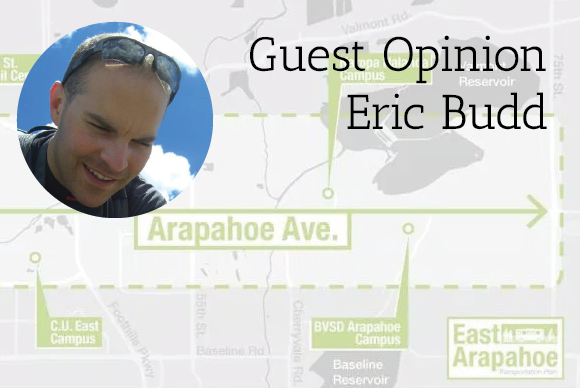By Eric Budd
Boulder’s East Arapahoe corridor, defined between Folsom and 75th streets, shows great promise to create places where people can live and work. The city of Boulder is currently developing its East Arapahoe transportation plan, which presents options to extend dedicated bus lanes, provide “bus rapid transit” with improved boarding and reduced wait times, and develop separated bike routes along the length of the road. Currently, the city is not considering changes in land-use along the corridor, which I consider to be a missed opportunity to make some new “15-minute” neighborhoods that our City Council desires. And while many residents have concerns about changing the character of surrounding neighborhoods, we can address those concerns by focusing the improvements to the areas directly alongside Arapahoe itself.
With a speed limit of 45 miles per hour, Arapahoe east of Foothills Parkway is neither a street nor a highway. The Strong Towns organization, an advocacy group for strengthening local communities, calls these street/road hybrids “stroads,” which have several negative effects. Stroads promote congestion and have speeds slower than a highway, making them ineffective at moving automobiles quickly and safely. But these roads also move automobiles too fast to function as a street, which is a place for people that builds value with shops, businesses, or gathering spaces. By mixing high-speed and turning automobile traffic with people who are on bikes or walking, street/road hybrids create a dangerous environment for all users.
These auto-centric corridors fail to provide productive financial or economic value to the city.
Several of the city’s proposed transportation options include expanded right-of-way, widening an already significantly wide road. But if you visit Arapahoe today, the avenue fails to give people a sense of place, largely due to broad building setbacks and an abundance of surface parking lots. Adopting design standards that focus on making places for people, along with making a complete street for buses, bikes, and pedestrians, could give the area a feeling of an intimate boulevard.
The Mason Corridor in Fort Collins provides a great example of how transit improvements can combine with new infill development, supported by the “MAX” bus rapid transit system, a bike trail, and several secure bike parking facilities. The Fort Collins project has also adapted its land use policies to allow for mixed-use redevelopment, providing buildings with retail shops on the ground floor, but also includes two to four stories of additional housing or office space. With added housing along the street, wait times for buses could be reduced from below the current 10-minute intervals for the “Jump” during peak time, potentially matching or besting the 7-8 minute intervals for the “Skip” on Broadway.
From the recent Boulder Valley Comprehensive Plan survey update, the top two desires from Boulder residents are more affordable housing options and the ability to get around with or without a car. A vision for Arapahoe can do both. The city needs to consider land use as a part of its plan to gain the real value wanted from this corridor and to make the significant transportation investments worthwhile. Arapahoe needs a rich mix of nearby jobs, housing, restaurants, breweries, climbing gyms, coffee shops, and other amenities in order to build a broader community in this part of town. Boulder needs to take this opportunity to make places that people want to live, work, and visit.

